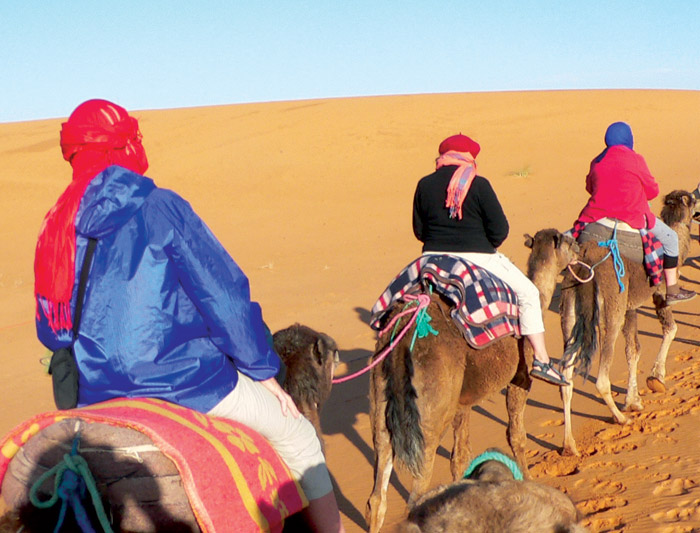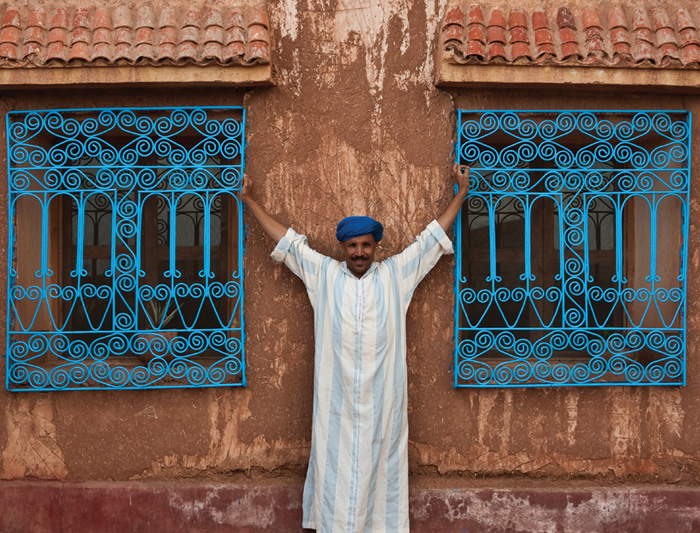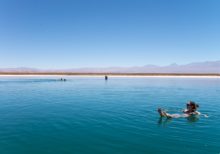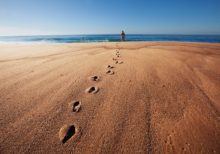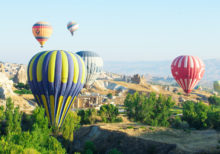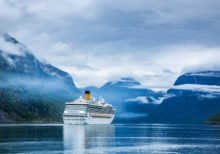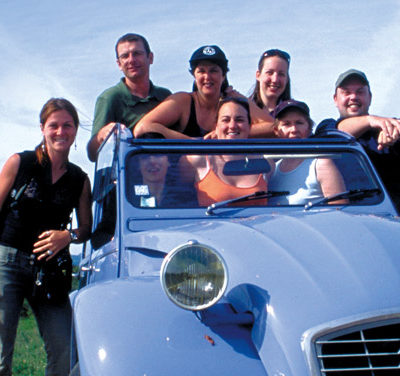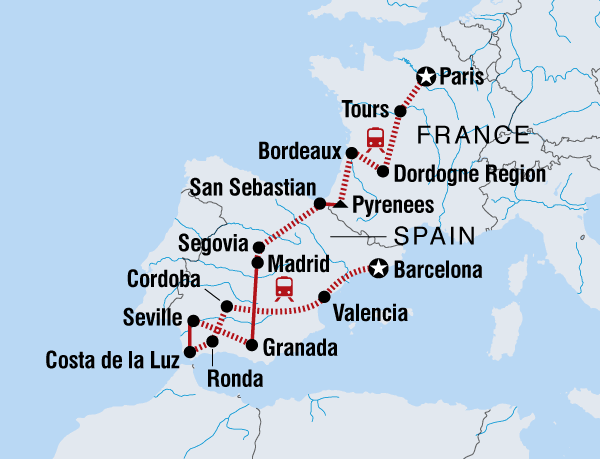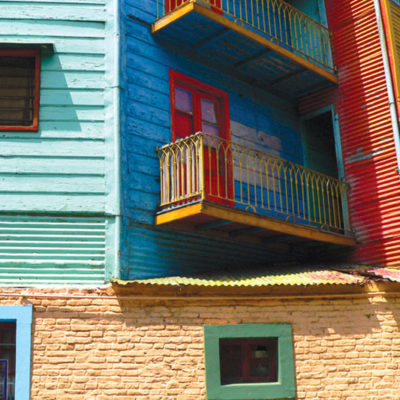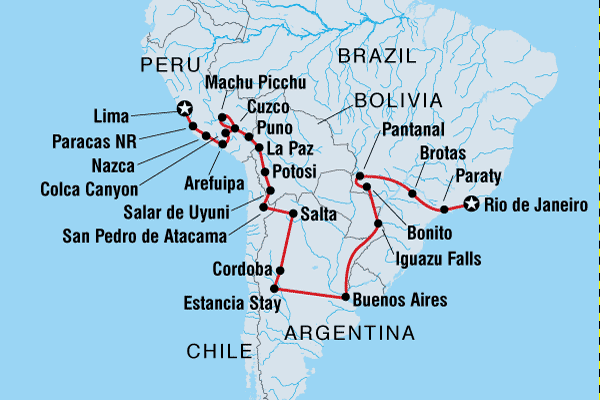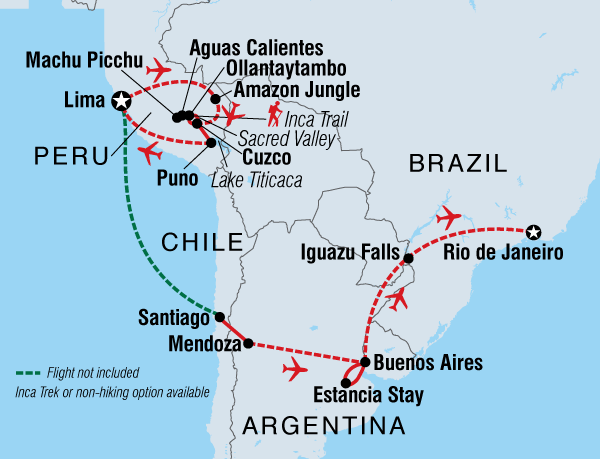| Starts | Madrid, Spain |
|---|---|
| Ends | Marrakech, Morocco |
| Region | Morocco |
| Duration | 24 days |
| Tour Operator | Intrepid Travel |
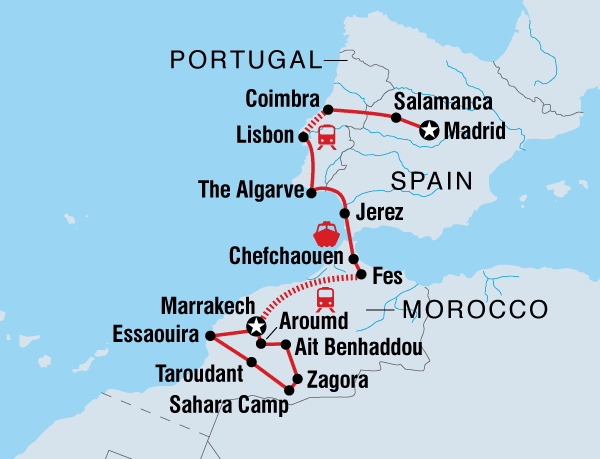
Itinerary
Day 1 - Starting: Madrid & Finishing: Madrid
Welcome to Madrid, Spain. The sassy central capital is known for its elegant boulevards and expansive, manicured parks, but it also pulsates with energy, and is without doubt a vibrant city. Your adventure begins with a welcome meeting at around 7pm – double check with reception to confirm the time and place. If you're going to be late, please inform the hotel reception. We'll be collecting your insurance, passport details and next of kin information at this meeting, so please have these on hand. If you can't arrange a flight that will have you arrive at the hotel by early evening, you may wish to arrive early. We'll be happy to book additional accommodation for you (subject to availability). As there's limited time for sightseeing in Madrid, we recommend arriving a few days early to explore. Perhaps while away the hours along the Paseo del Arte, or Art Walk, for an expansive history of Western art. Start with the Museo del Prado, then discover modern Spanish masters, including Picasso and Dali, in the Museo Reina Sofia. Finish at the Museo Thyssen-Bornemisza, which displays eight centuries of European painting. After the welcome meeting, perhaps get into the mind of a Madrileño with some tapas and Rioja.
Day 2 - Starting: Salamanca & Finishing: Salamanca
Say farewell to Madrid this morning and head north-west by bus to the historical university town of Salamanca (approximately 3.5 hours). Situated amongst beautiful pastures and rolling green hills on Spain's northern plateau, the rose-hued medieval town of Salamanca is great to explore on foot. Your leader will take you on an orientation walk on arrival, where you can explore the central Plaza Mayor and discover the beautiful Renaissance and baroque architecture of the historic stone buildings that the city is known for. Plaza Mayor is a true centre of local life, perhaps the most perfect city square in Spain. Not only is it architecturally unique, but it also thrives with activity as locals meet and take coffee, tapas or cocktails on the square. The rest of your afternoon and evening is then free. You can admire the intricate detail of the Casa de Las Conchas, or ‘House of the Shells’, see the contrasting Old and New Cathedrals, and climb to the top to get a view across the terracotta-coloured rooftops. Thanks to the large student population the town has a vibrant nightlife, so maybe soak up the buzzing vibe tonight.
Day 3 - Starting: Coimbra & Finishing: Coimbra
Head further west by bus today and cross the border into Portugal to the laidback city of Coimbra (approximately 5 hours). Coimbra will be your base for next two nights. Sitting dignified on the banks of the River Mondego, Coimbra was once the capital of the county, and its royal heritage can be felt in its ancient streets and buildings. On arrival, your leader will escort you on a walk to help you orientate yourself in the maze of alleyways of this riverfront city. Half the fun of Coimbra is wandering and exploring, so use your free time getting to know the city. Coimbra features typical white stone buildings with several excellent examples of colourful azulejos tiling. Some of the historical structures were originally built in the 12th century (like the Cathedral Sé Velha), and you can find some of the Portugal's best examples of Romanesque churches and elegant museums here. The University of Coimbra – the oldest in Portugal – and the famous baroque library, the Biblioteca Joanina, with its 18th-century bell tower, are highlights.
Day 4 - Starting: Coimbra & Finishing: Coimbra
Enjoy a free day of exploration in Coimbra before witnessing a traditional Fado performance in the splendour of a lovely old chapel (held daily in the centre of the old town). Fado songs must follow a particular structure, and though this traditional music can really be about anything, it popularly features mournful tunes with lyrics about the sea or the life of the poor. In Coimbra, male university students would often serenade their sweethearts with this music, with songs here tending to be literary translations or follow themes students can relate to. In your free time, perhaps head out into the countryside in search of ancient Roman ruins, which takes around 30 minutes by bus. The ruins of Conimbriga are rich in well-preserved mosaics and offer a great insight into ancient Roman life. There are several options to return, including a three kilometre walk through the countryside to the unspoiled rural town of Condeixa (optional). If you have time, you can take a short boat tour to take in the view of Coimbra from a different angle.
Day 5 - Starting: Lisbon & Finishing: Lisbon
Today, jump on a train through the countryside of central Portugal to Lisbon (approximately 3.5 hours). As one of Europe's most pleasant and affordable capital cities, Lisbon combines the best elements of Portuguese life, offering fantastic architecture, a multicultural population, delicious seafood and non-stop nightlife. On arrival to the city, head out on an orientation walk of Lisbon, city located on the banks of the Tagus (Tejo) River. Much of Lisbon’s character and charm lies in its beautiful renovated buildings, grand boulevards and impressive castles and churches. On the orientation walk of this truly one of Europe’s great cities, you will visit the medieval citadel in the city centre of Lisbon. Citadel of Sao Jorge Castle dates back to Moorish times and sits on the highest point of the Old Town. Look down on a city swarming with endless angular white houses and buildings with distinct red terracotta rooftops. From the citadel, this makes a contrasting panorama when viewed against the deep blue of the sky and ocean. Your afternoon and evening is then free, so perhaps see quirky pieces in the Folk Art Museum, or head to the grand Naval Museum for an insight into the history of Portuguese navigation. You can roam through the charming narrow streets of local neighbourhoods and see local life play out. A visit to the symbolic Lisbon Cathedral Belem Tower (a wonderful building originally designed as a lighthouse) is recommended, as is the vast, spectacular Monastery of the Jeronimos. Maybe simply sit back in one of many outdoors restaurants and cafes – watching the life go by is definitely one of the best ways to relax in Lisbon. Barrio Alto is the place to head to check out the nightlife.
Day 6 - Starting: Lisbon & Finishing: Lisbon
Today is free for you to explore more of Lisbon, or maybe take a 45 minute train ride out to the mountainous region of Sintra, an absolute jewel of Portugal. This area offers great walking, stunning cliff-top palaces and unique Moorish architecture. The 8th century Castle of the Moors looks down on the old town, and the views from the battlements across the Serra de Sintra mountain range are stunning.
Day 7 - Starting: The Algarve & Finishing: The Algarve
Take a long bus journey of around 5 hours today to the southern coastline of Portugal, the Algarve. Known for its fertile plains, rich with orange and olive groves, fig trees, almonds and maize fields, this region is perfect to explore on foot. Your base is Olhao, the Algarve’s biggest fishing port. With active waterfront, Moorish buildings and bustling old quarters, the city has a mystical feel of Northern Africa. Upon arrival check in to our home for next two nights and use the rest of the day to discover Olhao; you can wander the city centre and get a great view of the town from the church bell tower, perhaps try Olhao’s famous fish restaurants, or stroll along the coastal road Rua 5 de Outubro, the eastern Algarve’s food mile, filled with delicious and authentic local flavours.
Day 8 - Starting: The Algarve & Finishing: The Algarve
Today is free for you to enjoy as you please. Perhaps venture out on a beach excursion or even go further afield on a day long trip to explore Algarve in depth. If you feel like relaxing in Olhao for the day - do so! If you choose to head out to the nearby sandy islands, ask your leader to point you in a right direction to catch a small boat, used by locals on everyday basis to travel between the coast and the islands, and to carry all necessary supplies. Alternatively, stay on the mainland and use the area's great walking paths to access some of the Algarve's lesser-known spots. Head towards the Ria Formosa Nature Reserve, a beautiful landscape of canals, salt pans, lagoons and sand banks, separated from the Atlantic Ocean by a series of barrier islands. One of these is Ilha de Culatra, where you can wander along a series of boardwalks, leading away from the fishermen’s settlements, and cross over dunes and lagoons to beaches that are so long that they disappear into the haze of the horizon. Evenings are best spent watching breath-taking sunsets, and the best place to do so is Olhao’s old town, where you will also have a chance to try some true Portuguese fare.
Day 9 - Starting: Tarifa & Finishing: Tarifa
Leave Portugal behind and return to Spain, travelling by bus to the charming city of Seville. If the legends are to be believed, Seville was founded by Hercules and its origins are linked with the Tartessian civilisation. To the Romans it was Hispalis and to the Moors Isbiliya. After the Christian reconquest, it became thought of as the portal to the 'New World', and is today is the largest city in southern Spain. Known for its important monuments and fascinating history, Seville is universally famous for its vitality and flamboyance – the city of Carmen, Don Juan and Figaro. Seville is also well-known for its oranges, tapas and flamenco, all three of which are ingrained in the fabric of the city and its proud people. Enjoy a short orientation walk around the main sites of Seville and discover the best tapas places in town on an included tapas crawl. Later on in the afternoon, travel onwards to Tarifa, where you will stay overnight before hopping over to Africa the next day.
Day 10 - Starting: Chefchaouen & Finishing: Chefchaouen
Today will be a long day of travel as you leave Spain behind and head to Morocco. To prepare for the trip ahead, we will head out on a bodega tour and sample some of the finest sherries on offer. Then travel by bus to the port town of Algecira (approximately three hours). Here you'll enjoy spectacular views of the Rock of Gibraltar before catching another bus back to Tarifa. Ferry across the straits to the city of Tangier (approximately 1.5 hours). After leaving the ferry, journey by bus (around three hours) to arrive at a sleepy mountain town peppered with blue-washed buildings and ambient restaurants – Chefchaouen, which is in the centre of a mountainous agricultural region. There may not be much time to explore this rural retreat by the time you arrive today, but you might just have time to look over the architecture of the 15th-century Grand Mosque and the medina, the walled fortress of the Kasbah. Perhaps tuck into some popular local goats’ cheese or a tagine tonight, before settling into your hotel. Relax ahead of a walking tour tomorrow.
Day 11 - Starting: Chefchaouen & Finishing: Chefchaouen
Meet your local guide early in the day to explore the maze of streets in Chefchaouen. The ‘blue city’ is arguably one of the prettiest places in Morocco. Set against a wide valley and nestled between two peaks in the stunning Rif Mountains, Chefchaouen may take you by surprise. Its medina has been lovingly cared for with striking blue and whitewashed houses, red-tiled roofs and artistic doorways, and it's filled with handircrafts, while the main square has shops selling woven goods and small sweets. Much of Chefchaouen was recreated by Andalusian refugees escaping the Reconquistia, so you might feel like you're still in the hills of Spain while exploring its streets. Learn about general life in a small Moroccan community, visit a communal bakery, watch local women do their laundry, and walk up to a former church for a great view over the town that's nestled between two mountain peaks. As a popular shopping destination for handicrafts, carpets, blankets or woolen garments, you may also see the artisans at work. Possibly relax after your walking tour in a traditional Moroccan hammam.
Day 12 - Starting: Fes & Finishing: Fes
Say farewell to Chefchaouen today and take a public bus for around five hours to the spiritual and cultural heart of Morocco. Arrive in the city of Fes and step back in time at a medieval medina thick with exotic smells, tastes and sounds. Vibrant, noisy, fascinating and overwhelming – a visual and pungent feast for the senses – Fes is the mother of all medinas. Maybe fuel explorations of this imperial city with a glass of mint tea and some sweet Moroccan dates. Your day is free once you arrive, so perhaps get your bearings of the most complete medieval city in the Arab world. The adventurous may want to try a camel burger for dinner at a local restaurant in the medina. In the evening why not head off to enjoy a dinner of Moroccan specialities like harira (chickpea soup) and chicken-stuffed pastilla with couscous. You may also head to the Palais Jamai for a drink. Watching the sunset over the Medina while a dozen melodic prayer calls vie for attention is an experience you'll likely remember for a long time.
Day 13 - Starting: Fes & Finishing: Fes
Take a guided group walking tour of the old city, known locally as Fes el Bali. Step back into the Middle Ages in the labyrinth of the Medina, which is alive with craftsmen, markets, tanneries and mosques. Pass donkeys piled high with goods (this is one of the largest car-free urban zones in the world) and explore the specialty sections that divide the souk. Medieval Fes was one of the world's great centres of education and culture: both Islamic and Jewish. Its religious institutions and its libraries are legendary. Its mosques are of great renown. Look out for the Medersa Bou Inania, one of the city's most beautiful buildings, which has recently been restored and is now open to tourists. Pass the Belghazi Museum, Medresse el Attarine and the splendid Funduk Nejjarine, a beautifully restored 18th century inn. You'll also see the famous tannery, known for the iconic view overlooking its dye pits, and a ceramics factory where you can see potters working in the traditional way. After the tour, the afternoon is free for you to enjoy as you please. Notes: Today’s experience will include shopping in carefully selected places. As the receipt of commissions or kickbacks in exchange for recommending particular shops, services or activities is ingrained in the culture of the Moroccan tourism industry, Intrepid has established a centralised system of receiving and distributing payments from these recommended suppliers. For more information, please refer to ‘Important Notes’ section or talk to your Tour leader on the ground.
Day 14 - Starting: Marrakech & Finishing: Marrakech
Travel by train this morning to Marrakech (approximately 8 hours). Be enticed by the alluring scents and brilliant colours of the spice markets, the sounds of the musicians, the rich folds of carpets, delectable foods, acrobats and perfumed gardens. On arrival, head out on an included tour to see the Koutoubia Mosque and its minaret – famous throughout the world as one of the greatest minarets and the 'sister' to the Giralda in Seville. Please note it is not possible for non-Muslims to enter the minaret, and you will only visit its beautiful surroundings. If you have time, explore the ruins of Palais Badi, once one of the most beautiful palaces in the world, or comb the spectacular bazaar, where every step to a new souq brings a new smell, a new sight or a new gift to buy. Perhaps end you adventure with dinner with the group in the unique great square of Djemma el Fna. When night falls, it transforms into a hive of activity. Snake-charmers, henna-painters, performers and storytellers share the square with a street food bazaar, packed with stalls loaded with Moroccan delicacies.
Day 15 - Starting: Marrakech & Finishing: Marrakech
Today is free for you to enjoy as you please. Set out to discover Marrakech in more detail; mingle with the performers and fortune-tellers at Djemaa el-Fna or sample Moroccan fares alfresco at the night stalls. Later, relax while sipping mint tea with locals and pick up last-minute supplies for the South Morocco adventure. As this is a combination trip, your group leader and the composition of your group may change at this location. There will be a group meeting to discuss the next stage of your itinerary and you're welcome to attend, as this is a great chance to meet your new fellow travellers.
Day 16 - Starting: Aroumd & Finishing: Aroumd
Today, take a short drive up the towering High Atlas Mountains to the village of Imlil (approximately 2 hours), photographing snow-dappled mountains and valleys in full flower along the way. On arrival, store your main luggage and load daypacks onto pack mules before walking into traditional mountain village life with a one-hour trek up to the peaceful village of Aroumd. If you feel like the walk is too strenuous then there's the option of riding the mule. Perched on a rocky outcrop, the remote village of Aroumd offers stunning views across the High Atlas Mountains and a unique opportunity to experience traditional Berber culture. Spend the night in a family-run mountain home (gite) in Aroumd. Surrounded by the smell of woodstoves and bread, meet the host family and enjoy Berber hospitality and food. Facilities at the homestay are shared (both the bathroom and sleeping arrangements) but cosy, comfortable and definitely a unique Intrepid experience. Use the rest of the day to explore the village and the surrounding farmlands. If the group are up for it, there will be a chance to hike of around eight kilometres to the pilgrimage shrine of Sidi Chamharouch (approximately 4 hours return). Regardless of fitness levels, the gentle pace of Aroumd makes it a special place to explore beyond the reach of the modern world.
Day 17 - Starting: Ait Benhaddou & Finishing: Ait Benhaddou
This morning journey along mountain roads and over Morocco's highest pass, Tizi n'Tichka (2,260 metres), to Ait Benhaddou on the edges of the Sahara (approximately 6 hours). Perched on a hilltop and almost unchanged since the 11th century, Ait Benhaddou is one of Morocco's most iconic site. It was once an important stop for caravans passing through as they carried salt across the Sahara, returning with gold, ivory and slaves. Today its grand kasbah has been listed as a World Heritage site, with its fortified village being a fine example of clay architecture. If you think you recognise the place, you probably do, as the town has a long list of film and TV credits, including Lawrence of Arabia, Game of Thrones and Gladiator. Enjoy a walk through the winding streets of old town, making your way to the top of the hill, from where you can enjoy the views across the surrounding plains. In the evening, why not join a simple cooking demonstration of Morocco's most famous cuisine: couscous and tagine. The locals will explain the secrets and subtleties of these traditional meals, as the ladies of the kitchen prepare a feast.
Day 18 - Starting: Zagora & Finishing: Zagora
This morning you'll journey south towards the Sahara, stopping in the regularly used film location of Ouarzazate along the way (approximately 5 hours in total). While here, make a short visit to Horizon Association for People with Disabilities. This is an organisation dedicated to the rehabilitation, health and empowerment of people with disabilities. Some of the services they provide include the building and fitting of prosthetic limbs and custom-made wheelchairs, and physio and social therapy for sufferers of accidents and illness. They also operate an artisan workshop, which trains local people in trades such as pottery, weaving, metal work and jewellery making. Since their establishment in 1994, the Horizon Association has served over 3,000 people. We're very proud to support this project through The Intrepid Foundation. Continue to travel through the lush Draa Valley to Zagora, a small oasis town on the Sahara fringe that is perfect for an overnight stop. Take a stroll through the palm groves, explore the ksars and wander around the surrounding countryside.
Day 19 - Starting: Sahara Camp & Finishing: Sahara Camp
Continue along the rugged and desolate Jbel Tadrart ranges and through seas of sand and past the occasional desert oasis of date palms to the township of Tamegroute. Visit an intriguing library filled with ancient scripts of science, literature, the Koran and stories of the prophet Mohammed (subject to unregulated opening times). Join a local guide to uncover the underground Kasbah and its unique ceramic pottery industry. Leave Tamegroute behind and carry on driving to the end of the road at the frontier town of M'Hamid (approximately 1 hour). From here, take a short camel ride through the dunes, where you’ll jump into 4WD vehicles. The rough track runs parallel to the Algerian border, across the stony Hamada desert, whose only populace is small scatterings of nomadic people and their camels. The group will reach the massive Erg Chigaga dunes in the late afternoon. An erg is a vast sea of shifting wind-swept sand that's formed into picturesque, undulating crests and valleys. The Erg Chigaga is one of the world's iconic landscapes, with towering dunes up to 150 metres in height. Your camp for the night is fairly basic with bedding, mattresses and toilet facilities provided. During the winter months of November to March it can get very cold at night, so it’s a good idea to bring base layers and a warm sleeping bag. Notes: Due to passenger feedback, all departures in the summer months of June, July and August use a slightly altered itinerary in the Sahara. We'll take a 4WD safari to the remote Erg Chigaga dunes, but instead of camping in the dunes you’ll stay at a fixed camp in Ouled Idriss. This camp is better suited for high summer temperatures.
Day 20 - Starting: Taroudannt & Finishing: Taroudannt
Today rejoin the minivan and venture towards the market town of Taroudannt, sometimes called ‘Little Marrakesh’. The journey should take around six hours in total. This drive goes through desert scenery and along a route that's a reserve for the indigenous argan trees. Argan oil is highly prized for its culinary, cosmetic and medicinal uses and is only produced in Morocco, and is certainly a trademark of Morocco around the world. If you're lucky, the group might come across the famous image of goats climbing these trees in search of nuts. Please note that this is a long travel day, and you won't arrive at tonight's accommodation until late afternoon/early evening. The riad (house) tonight is 45 kilometres outside of Taroudannt and offers the chance to relax by the pool or take a steamed bath.
Day 21 - Starting: Essaouira & Finishing: Essaouira
In the morning, take to the souqs and haggle with local traders for silver jewellery or colourful Moroccan ceramics and mosaics. Afterwards, leave the valleys of the High Atlas Mountains behind and head west to the coastal town of Essaouira (approximately 5 hours). The name Essaouira means image, which is appropriate since it's such a picturesque town. Its charm is undeniable; within the stone ramparts you'll find whitewashed houses with bright blue shutters, art galleries and wood workshops. This laidback artists' town is a former Portuguese trading colony and was once home to sizeable British and Jewish populations. The town faces a group of rocky islands, called the Mogador, and is surrounded by an expanse of sandy beaches and dunes. It's still a busy fishing port and its pretty harbour is filled with tiny colourful boats which go out early every morning for the day's catch. Visitors who have been seduced by its charms include Orson Welles and Jimi Hendrix, who (according to local legend) spent much of his time here in the 1960s. More recently, filmmaker Ridley Scott chose the ramparts as an important location for his film, Kingdom of Heaven. As you’ll arrive in the early evening, there won’t be much time to look around today. In the evening perhaps have some dinner with the group, as the local seafood is as fresh as it gets.
Day 22 - Starting: Essaouira & Finishing: Essaouira
Today, join a local guide for a walking tour through the old medina, Jewish mellah, port and skala (sea wall). Afterwards, use your free time to get under the skin of the town. The narrow streets of Essaouira are ideal for casual exploration. Their size discourages cars, and on walk through the town it feels as though little has changed since the days of sea pirates. The fishing port is a serious commercial operation and there’s much fun to be had observing the daily catch and its subsequent auction. A freshly-cooked plate of the day's catch is highly recommended. Browse the plentiful shops and intriguing art galleries that make this little town a particularly pleasant place to unwind for a few days. It has a growing reputation for its unique art and is becoming even more famous for its burled Thuya wood, delicately formed and inlaid in tiny shops that are built into the thick walls of the Portuguese ramparts. The scent from the oils used to polish the richly coloured wood permeates the air and makes walking down the streets incredibly pleasant. If you’d prefer to relax, don't miss the opportunity to indulge in a hammam or local-style bath.
Day 23 - Starting: Marrakech & Finishing: Marrakech
Use the morning to see the last of Essaouira, as you’ll catch a bus back to Marrakech in the afternoon (approximately 3 hours). The monuments of Marrakech are numerous and range from the well-known Koutoubia Mosque and its superb minaret to the lesser-known tropical gardens of the French painter Jacques Majorelle (now owned by Yves Saint Laurent). There's the Palais Bahia, a superb example of Muslim architecture, and the ruins of the Palais Badi, reputedly one of the most beautiful palaces in the world in its time. The Saadian tombs are a recently uncovered gem of the Medina. All of the above can be a challenge to locate, but that's all part of the experience of exploring the phenomenal medinas of Morocco. Explore the Medina for some last-minute shopping, where every step brings a new smell, a new sight or a new gift to buy. This evening you will likely be drawn back to the Djemaa El-Fna, and its surrounding medina. When night falls on this square it transforms in to a hive of activity. Snake-charmers, henna-painters, performers and storytellers share the square with a street food bazaar, packed with stalls loaded with Moroccan delicacies. Perhaps dine with the group here – a great way to finish your adventure.
Day 24 - Starting: Marrakech & Finishing: Marrakech
Your 'Spain, Portugal & Morocco' adventure ends after breakfast. Check out time is usually around 12.00pm, but you’re free to leave any time before. Additional accommodation can be pre-booked if you wish to spend more time exploring Marrakech (subject to availability).
View Dates

